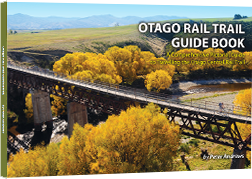Lauder to Oturehua Distance: 23 km
- After crossing State Highway 85, the trail takes you over the Manuherikia Bridge No. 1. An impressive curved concrete structure 110.6 metres long and 14 metres tall.
- Approximately 10 metres before entering the Poolburn Tunnel No. 2, on the left is a path with a safety rail that takes you to remnants of the Linemen’s Base used during rail construction in the Poolburn Gorge.
- It is hard not to feel sympathy for the linemen who built the railway using hard physical labour, wheelbarrow, pick, shovel, horse and cart.
- Returning to the trail, switch on your torch and walk your bike through the Poolburn Tunnel No. 2. At 229 metres it’s the Rail Trail’s longest.
- Further up the gorge is the Poolburn Tunnel 1. Because the railway was built from Middlemarch, this was the first of the two Poolburn Gorge tunnels.
- Back into daylight it’s only a short distance to the 37 metre high Poolburn Viaduct, arguably the most imposing structure on the Rail Trail.
- The viaduct’s huge rock piers and abutments were quarried from local outcrops and crafted by stone masons to a standard seldom seen today.
- Be sure to read the information panel at the eastern (Oturehua) end of the viaduct.
- Descending the slopes of this northern part of Raggedy Range, you are treated to brilliant views of the spectacular Hawkdun Mountain Range and North Rough Ridge.
- After leaving the Poolburn Gorge, and having possibly caught a glimpse of the swept-wing New Zealand native falcon (karearea), you reach the Auripo Station where today nothing much remains.
- The Ida Valley opens up in front of you. Known for its extremely harsh climate, during winter months, the valley floor is often cloaked in thick fog. .
- Be sure to stop to take a look at the now privately owned Ida Valley Railway Hotel. This historic building is easily viewed from the trail or public road.
- On the outskirts of Oturehua the trail crosses Ida Valley Road to the Idaburn Dam. During cold winters the dam can freeze to a depth suitable for curling competitions and when conditions are perfect, a curling bonspiel.
- Just along from Idaburn Dam and back across the Ida Valley Road is the clearly signposted Hayes Engineering Works and Homestead (look for the windmill). Here Ernest Hayes forged many labour-saving inventions with his most famous being the Hayes Wire Strainer. Perfected in 1924, it is still used on fences throughout the world. The historic mud brick buildings are very photogenic.
Lauder to Oturehua Distance: 23 km
- After crossing State Highway 85, the trail takes you over the Manuherikia Bridge No. 1. An impressive curved concrete structure 110.6 metres long and 14 metres tall.
- Approximately 10 metres before entering the Poolburn Tunnel No. 2, on the left is a path with a safety rail that takes you to remnants of the Linemen’s Base used during rail construction in the Poolburn Gorge.
- It is hard not to feel sympathy for the linemen who built the railway using hard physical labour, wheelbarrow, pick, shovel, horse and cart.
- Returning to the trail, switch on your torch and walk your bike through the Poolburn Tunnel No. 2. At 229 metres it’s the Rail Trail’s longest.
- Further up the gorge is the Poolburn Tunnel 1. Because the railway was built from Middlemarch, this was the first of the two Poolburn Gorge tunnels.
- Back into daylight it’s only a short distance to the 37 metre high Poolburn Viaduct, arguably the most imposing structure on the Rail Trail.
- The viaduct’s huge rock piers and abutments were quarried from local outcrops and crafted by stone masons to a standard seldom seen today.
- Be sure to read the information panel at the eastern (Oturehua) end of the viaduct.
- Descending the slopes of this northern part of Raggedy Range, you are treated to brilliant views of the spectacular Hawkdun Mountain Range and North Rough Ridge.
- After leaving the Poolburn Gorge, and having possibly caught a glimpse of the swept-wing New Zealand native falcon (karearea), you reach the Auripo Station where today nothing much remains.
- The Ida Valley opens up in front of you. Known for its extremely harsh climate, during winter months, the valley floor is often cloaked in thick fog. .
- Be sure to stop to take a look at the now privately owned Ida Valley Railway Hotel. This historic building is easily viewed from the trail or public road.
- On the outskirts of Oturehua the trail crosses Ida Valley Road to the Idaburn Dam. During cold winters the dam can freeze to a depth suitable for curling competitions and when conditions are perfect, a curling bonspiel.
- Just along from Idaburn Dam and back across the Ida Valley Road is the clearly signposted Hayes Engineering Works and Homestead (look for the windmill). Here Ernest Hayes forged many labour-saving inventions with his most famous being the Hayes Wire Strainer. Perfected in 1924, it is still used on fences throughout the world. The historic mud brick buildings are very photogenic.
Manuherikia Bridge No. 1
The Manuherikia Bridge No. 1 that is 110 metres in length with the Manuherikia stream 14 metres below.
Relics of the Linemen’s Base
Approximately 10 metres before the entrance of the Poolburn Tunnel No. 2 is a path on the left side with a safety rail. This short path brings you to relics of the Linemen’s Base, used during the rail construction through the Poolburn Gorge.
Poolburn Tunnel No. 2
The Poolburn Tunnel No. 2 is the longest tunnel on the trail at 229 metres.
Poolburn Tunnel No. 1
The Poolburn Tunnel No. 1 is 201 metre.
Poolburn Viaduct
The Poolburn Viaduct is arguably the most impressive structure on the Rail Trail.
Ida Valley
The valley is known for its extremely harsh climate over the winter months and is prone to fog on the valley floor.
Original Ida Valley Railway Hotel
The original old Ida Valley Railway Hotel which is privately owned but can be viewed fromthe trail or public road.
Idaburn Dam
the Idaburn Dam comes alive in winter when the ice forms and a bonspiel or curling competition takes place.


















